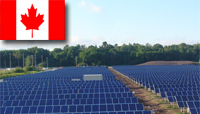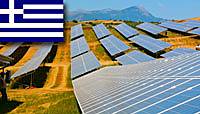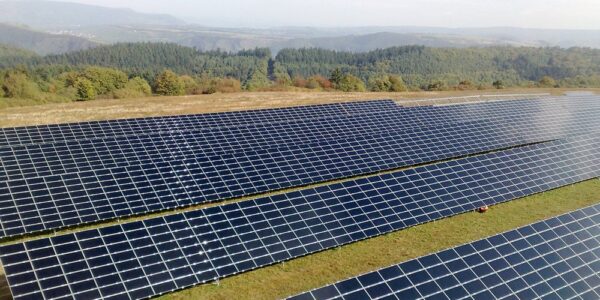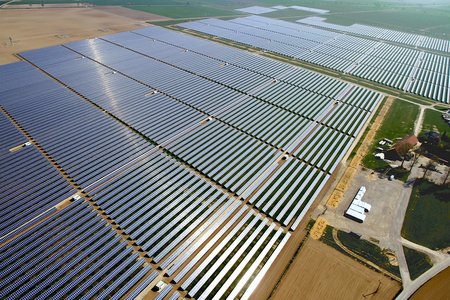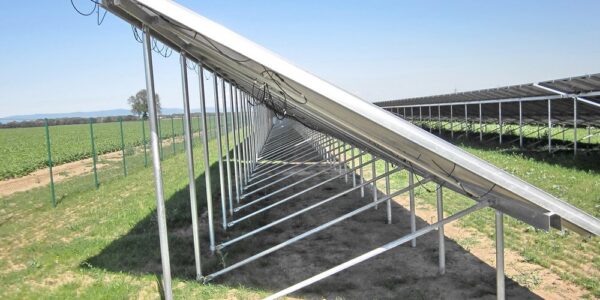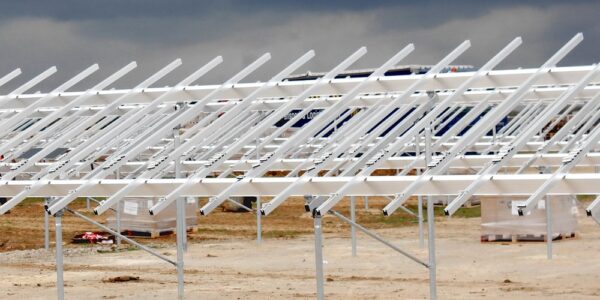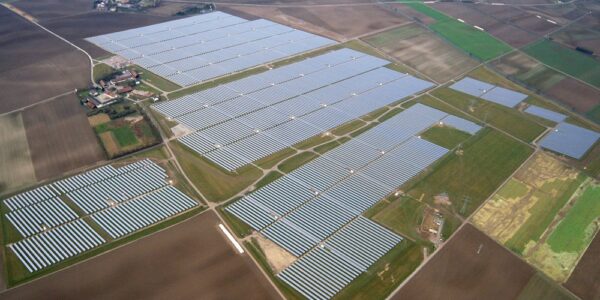Open-Field Photovoltaic System
An open-air photovoltaic system (also known as a solar park) is a photovoltaic system that is not installed on a building or on a facade, but on an open area at ground level. A ground-mounted system is a permanently installed system in which the photovoltaic modules are aligned at an optimal angle to the sun (azimuth) by means of a substructure.
Agri-photovoltaics (abbr .: Agri-PV, also Agrar-PV or Agro-PV) is a special form of the photovoltaic open space system. Not the entire open space is dedicated to photovoltaics here. Instead, the open space is used for photovoltaics and agriculture at the same time. This is achieved by installing the photovoltaic systems so high that agricultural vehicles can drive under them. The degree of shading of the agricultural area can be determined by the ratio of the area of the modules to the open area. In the course of climate change, this technology is gaining in importance because the drying out of the soil and damage to plants can be reduced by too intense solar radiation.
In addition to these permanently mounted open-space systems, there are also tracking systems, so-called tracker systems, which follow the position of the sun. There are also photovoltaic systems installed on floats that float on lakes (e.g. dredging holes) (#see below).
As of 2020, solar parks in the best locations worldwide can produce electricity production costs of well below 2 US cents / kWh. [1] In addition, the space efficiency of solar parks is comparatively high: solar parks supply around 25 to 65 times as much electricity per unit
Open spaces and environmental protection
In 2005, together with the nature conservation organization NABU, the Solar Industry Association (UVS) managed a catalog of responsibilities for the environmentally friendly construction of open-space systems. Accordingly, areas should be avoided with reservations and with ecological significance and exposure on elevations that are visible in the intestine. The resurrection should be done in such a way that extensive use and care of the vegetation, e.g. B. through sheep grazing, remains possible longer. The use of pesticides and liquid manure should be avoided. Conservation associations will be closed in planning; possibly is – z. B. in IBAs – an impact assessment is checked. A monitoring of the development of the natural balance from the point of view of inspections after construction. The form of behavior of ecological behavior here goes beyond the understanding of the minimum required. This voluntary commitment should be maintained by project planners and representatives when choosing a location and operating large-scale solar systems installed at ground level. [23]
Studies from 2013 show that solar systems make a high contribution to regional biodiversity and the installation of a solar park enables a significant ecological upgrading of the areas compared to arable or intensive grassland use. In addition to the age of the systems, this is the different delivery biotopes, the possible less than 500 m visible, the possible factor for immigration and the biodiversity of the system. The various systems with the right to biodiversity in the surrounding area feel that they are the best systems with better diversity in the study. Already subsequently time control the extensification of the ability to work to an immigration of butterflies and an increasing variety of plants. In addition, the associated use of the solar park is very important for ecological diversity: too much grazing has a negative effect. Certain of some mobile animal species such as butterflies have already been repopulated in the areas after time. In four of the five possible solar parks, the biodiversity of animals, the intensive field use received with the perception, was indicated. [24]
Floating photovoltaic open space systems
On inland lakes, photovoltaic systems can be installed on floating bodies, for example hollow HDPE blocks. Their efficiency is slightly higher than that of comparable systems on land because they are cooled by the water. [36]
In 2008 the first commercial plant was put into operation. [37]
In March 2016, a floating system with 6.3 MWp installed on the Queen Elizabeth II reservoir near Walton-on-Thames went into operation. [38] [39]
In 2017 a 40 MWp plant (at that time the world’s largest plant) went into operation in Huainan (PR China). The facility extends over 93 hectares and has 132,400 solar modules. [40]
On a quarry pond near Zwolle (Netherlands), the company BayWa r.e. install a 14.5 MW system. It covers about 10 hectares of the lake.
For more information, please contact our experts who are at your disposal with advice and action.
See below pictures of solar fields that were delivered and built by us and our partners.
No earthworks or concrete work are required for our assembly of the solar fields.
We work with screw foundations
Solar power from your own solar system is one of the most environmentally friendly and inexpensive ways to supply your household with electricity. Buying a solar system is worthwhile for more and more people.
There are so many kinds of solar types and offerings we only want to describe a part here.
For a detailed calculation and offer, please contact our specialist department.
We and our partners will advise you to your complete satisfaction and offer you the appropriate system for your needs.
On-grid and off-grid
Grid is initially just the English word for network – what is meant in connection with photovoltaics is an existing power grid. For photovoltaics, the two terms on-grid and off-grid are essential, as they denote different concepts of photovoltaic systems.
On-grid system in photovoltaics
An on-grid system is a photovoltaic system that generates electricity, this solar electricity then being fed into an existing public network. In addition to the solar generator (i.e. the interconnected modules), an inverter is required because alternating current flows in public power grids. With on-grid systems, a distinction is made between different concepts in photovoltaics:
On-grid systems in which the photovoltaic system is used to supply a consumer in parallel to the public grid. The decentralized solar energy is produced close to the consumer, so that large transport losses can be excluded.
On-grid systems in which the photovoltaic system supplies the consumer as an alternative to the public grid. The consumer is also connected to the public grid, the solar power is produced locally, i.e. close to consumption. Instead of feeding surpluses into the public grid, these are primarily stored in an energy storage system. Above all, this on-grid system ensures greater security of supply and is often used in weaker supply networks, as a so-called backup system.
On-grid systems that supply consumers in parallel with the public grid are the well-known grid-connected systems that are common in Germany and other industrialized countries. On-grid systems that perform a so-called backup function are more likely to be used in emerging or developing countries.
Off-grid system in photovoltaics
An off-grid system is an island system. Such a photovoltaic system is therefore not connected to a public power grid and only works with energy storage. Such off-grid systems or island systems had larger market shares in the early days of phovoltaics. Today they are primarily used in holiday homes or mountain huts that are not connected to a public network because of the great distance. Off-grid photovoltaic systems are also used in boats or mobile homes. Another area of application for off-grid photovoltaics is, for example, in the operation of desalination plants or water pumps. Their market share is growing especially in developing countries. According to estimates by Greenpeace, two billion people will be supplied with electricity via off-grid systems by 2030.

The solar modules are the crucial component of a photovoltaic system. Depending on their size, a different number of solar cells are interconnected in them. For a photovoltaic system, several solar modules are in turn connected to form so-called strings. Several strings then make up the entire solar generator.
Function of a solar cell
A solar cell is ultimately a semiconductor diode. Here the radiation energy is converted into direct current. This can be explained physically by the so-called photo effect. Different doped semiconductor layers are put together in a solar cell. At the junction between these two layers (one positive, the other negative), the p-n junction, an electric field is created that separates the two layers and prevents the charges from equalizing. At the same time, the boundary layer allows the current to only flow in one direction when the circuit is closed.
Which solar modules are there?
4 common solar module types in comparison
monocrystalline PV modules.
polycrystalline PV modules.
Thin-film PV modules (also simply called thin-film modules)
CIGS PV modules (also simply called CIGS modules)

The selection of photovoltaic modules from different brands, manufacturers and performance classes is large and confusing. After all, there are now a large number of manufacturers, primarily from Asia, who produce high-quality PV modules and bring them onto the global market at increasingly lower prices.
These crystalline modules, which include polycrystalline but also monocrystalline solar modules with a particularly high level of efficiency, offer different performance and thus yield rates that should be taken into account when planning your own photovoltaic system. As a rule, a distinction can be made between simple standard modules, special design variants or high-performance photovoltaic modules.
High-performance photovoltaic modules
Anyone interested in buying a PV system will quickly find out that there are now a wide variety of types of solar modules. In addition to the classic poly- or monocrystalline modules, amorphous or flexible solar modules are also mentioned again and again. These consist of a thin layer of solar cells that is applied to a suitable carrier material. However, the efficiency of such modules is usually low, which is why they have not yet been used in conventional solar systems. Instead, monocrystalline modules in particular are enjoying steadily growing popularity.
In short: Monocrystalline high-performance modules have a high degree of efficiency. As a result, they promise higher yields and excellent low light behavior. While the standard and design solar modules deliver an average output of 300 Wp and are therefore ideally suited for roofs with sufficient space, the high-performance PV modules are therefore primarily predestined for roofs with little space. With efficiencies of up to 22%, many of the monocrystalline modules offer an output of over 350 Wp.
But the monocrystalline modules are not only used in PV systems on small roofs. More and more, they are also chosen because of their black color, which goes back to their form of manufacture. In contrast to the bluish shimmering polycrystalline solar modules, several silicon crystals are not used here. Instead, a monocrystalline solar cell consists of a single silicon crystal. This makes the solar cell appear black to anthracite and at the same time ensures a higher degree of efficiency.
In this post we introduce you to some of the most famous high-performance solar modules. In this way you get an initial overview of the individual models and find out what properties they bring with them. You can also select some of the models as part of your request in the zolar online configurator. Here you have the opportunity to choose between standard solar modules, design photovoltaic modules and high-performance PV modules with increased yields.
Solar Lamps
A-Price List of Solar Lamp 2-1pdf-1
We have many kinds of small solar products like :
Inverter, charge box, battery, solar lights, solar lamps, flood lights, and so on
Please tell us what you need and we deliver it.
New Price List for solar street light -2020 2pdf
A-Price List of Solar Lamp 2-1pdf-1


